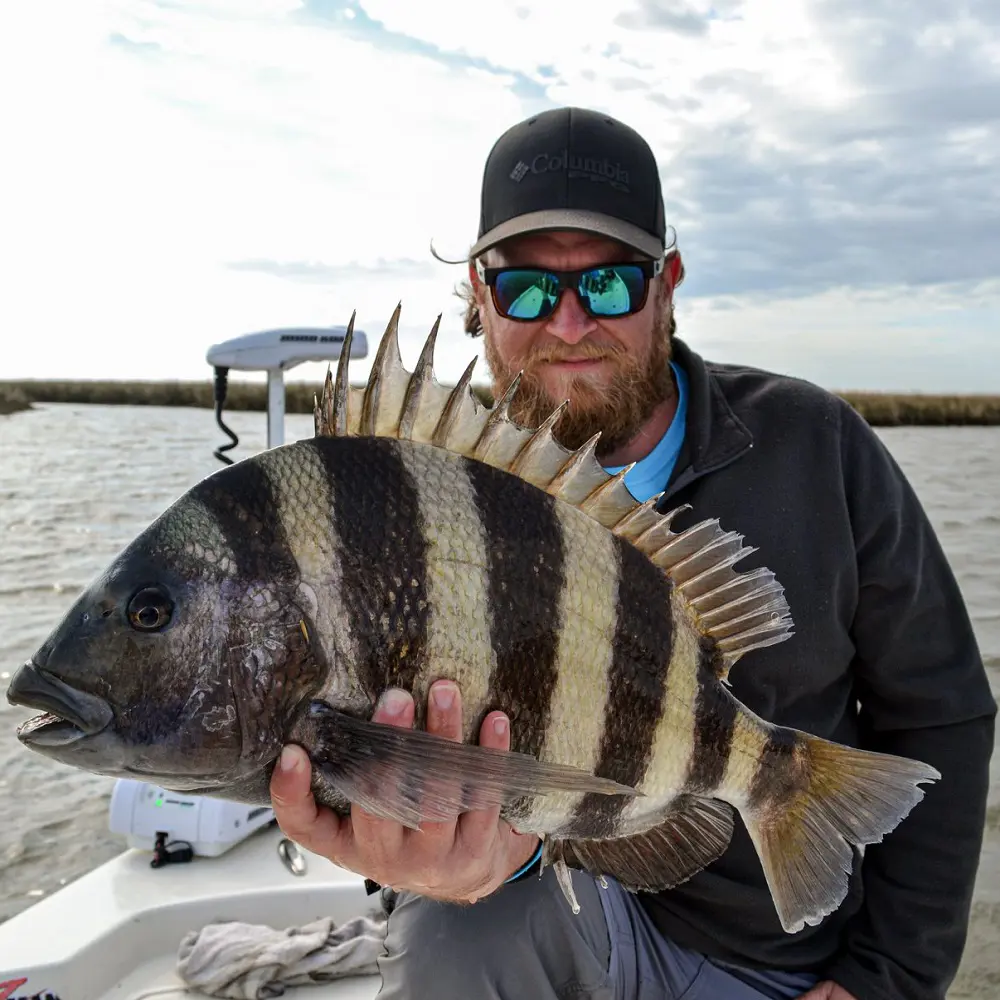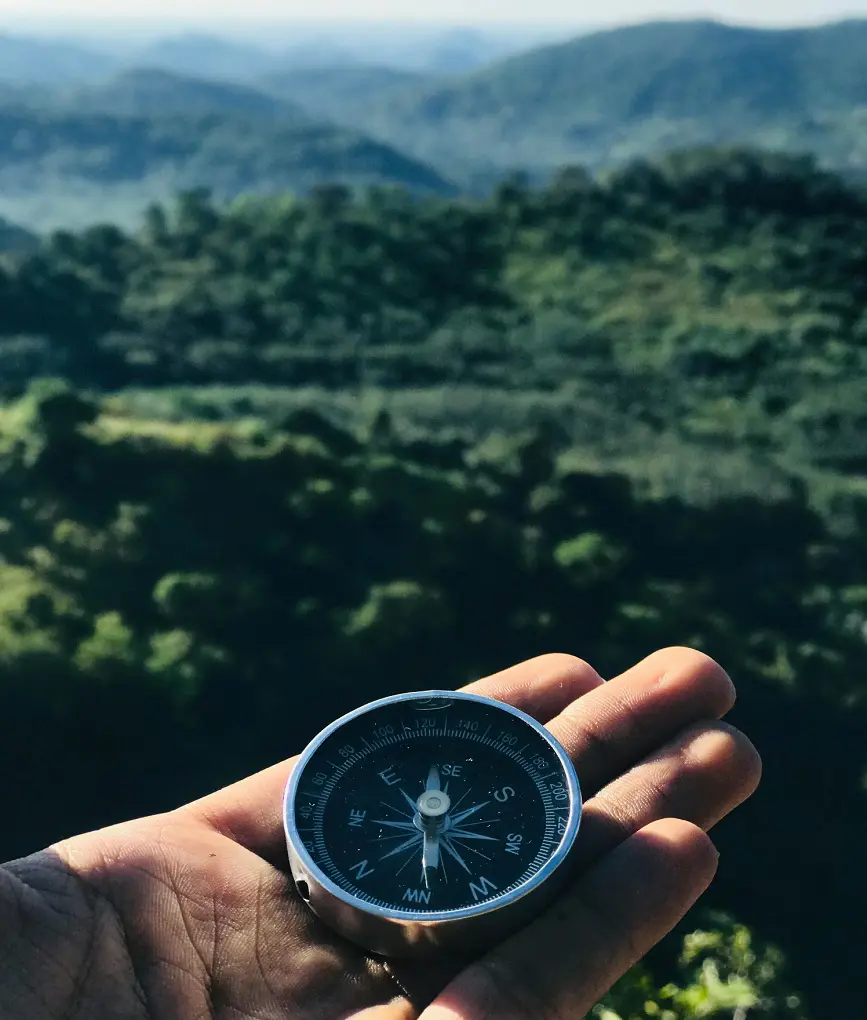Fishing Sheepshead is quite a challenging task because they are among the most picky eaters so it won't be easy to hook them but they are easy to find. They are a fascinating type of fish and arguably one of the most underrated among inshore game fish.
Finding a location close to piers, docks, or rock jetties is the first step in going sheepshead fishing. They are known to eat barnacles, crabs, and shellfish. Use a light to medium-sized rod, and a strongest material abrasion-resistant line on the reel. Shrimp, fiddler crabs, or oysters are the best options for bait. Below are some of the tips and tricks to catch Sheepshead:
1. Selecting the Proper Bait
It is important to choose the proper bait for fishing the Sheepshead. Mud crabs are the most useful among the available solutions. Sheepshead are fierce hunters of these crustaceans, which are typically found in oyster beds. When the oysters are exposed at low tide, it is best to look for mud crabs.
Although there may be some similarities between mud crabs and stone crabs, it is important to distinguish between the two. Regardless of age, stone crabs have characteristic white bands on their legs, unlike mud crabs. They are a favorite option because of their resilience to damage by non-target fish and their durability on the hook.
The choice of bait is normally influenced by regional availability and personal taste, so if you keep these things about bait in mind, you have a high chance of catching Sheepshead.
Here are some of the best baits to use on sheepshead apart from mud crabs:
- Clams
- Fiddler crabs
- Mussels
- Barnacles
- Shrimp
2. Using the Right Gear

The ability of the angler to identify bites, set hooks efficiently, and manage the Sheepshead fish throughout the fight may all be greatly improved by using the proper gear. A dependable reel, braided line, and a medium-power spinning rod are usually the components of sheepshead fishing gear.
The medium power of the rod gives enough support to offset the strength of the fish and keep the line from breaking, particularly when hunting sheepshead close to structures. The majority of fishing places' average sheepshead sizes may usually be handled with a reel in the 3000 size class.
Superb sensitivity, abrasion resistance, and low stretch are characteristics of braided lines, that are critical for spotting minor sheepshead bites and retaining control during the battle. Thus, a medium power rating rod that is shorter in length can be the best choice for anglers that mainly target sheepshead.
3. Look for Structure
As Sheepshead are structure-oriented fish, they normally gather around things that offer food or cover. This might include artificial structures such as jetties, docks, and bridges, as well as underwater rocks and oyster reefs. Look for sheepshead in places where there is a lot of structure.
Seek out locations with a diversity of structures because different kinds of structures could draw different kinds of fish. Besides, look for the water's depth and the flow of current surrounding the structure, since these elements may have an impact on the sheepshead's existence and activity.
Moreover, fishers are more likely to get the sheepshead or at least come close to capturing them if they locate and focus on areas with appropriate structures.
4. Use a Sensitive Rig

Sheepshead are known for being a notoriously light biter, often exhibiting subtle nibbles that can be difficult to detect. Therefore, employing a highly sensitive rig is crucial for successful sheepshead fishing. A sensitive rig allows anglers to perceive even the most delicate strikes, preventing missed opportunities and increasing the likelihood of landing fish.
The key components of a sensitive sheepshead rig include a fine-diameter line, a sensitive rod, and a sharp, barbless hook. A fine-diameter line, such as fluorocarbon or superbraid, minimizes line resistance and allows for better sensitivity. A sensitive rod, with a supple tip and a moderate backbone, is essential for detecting subtle bites and providing ample power during the fight.
A sharp, barbless hook enhances hook-up rates and minimizes fish injuries, ensuring a more ethical and sustainable fishing experience. By utilizing a sensitive rig, anglers can significantly improve their ability to detect and land sheepshead, making the most of their fishing adventures.
5. Observe and Be Patient
You need to have a high level of patience level as well as be a good observer to catch a fish, especially when you are looking to catch Sheepshead. Anglers may learn a great value about the behavior of these fish by closely watching their eating habits, surroundings, and strike indications.
Indications for possible feeding sites and the time of their strikes may be obtained by tracking their movements and interactions with the surroundings. Fishing is among the slow and tiresome activities, so you must constantly keep your eye on the rod. Fishing teaches you many things, patience being one of them.
It may take some time for these fish, who are often very picky, to show an interest in an angler's bait and get caught in it. Yet, anglers are likely to get one if they keep their focus and attention.
Likewise, being alert to other factors like tides, currents as well as weather conditions can help affect the fish's behavior too. Hence, if you follow this tip, you are more likely to succeed.
6. Fish During the Tides

During rising tides, water levels increase, inundating shallow areas and bringing nutrients and food items closer to shore. This influx of resources can attract sheepshead to areas that were previously inaccessible, increasing their abundance and improving fishing opportunities.
As the tide rises, sheepshead may move from deeper waters to shallower areas in search of food, making them more susceptible to anglers fishing from the shore or small boats. Conversely, falling tides can concentrate sheepshead in deeper pools or around structures as they seek refuge from the receding water.
Understanding the tidal patterns in a particular fishing area is essential for maximizing success. By timing fishing trips to coincide with favorable tidal phases, anglers can increase their chances of encountering and landing sheepshead, making the most of their fishing adventures.
7. Chum the Waters
Chumming is one useful tactic for catching sheepshead fish. It simply is the process of putting food or bait into the water to draw fish. Anglers can increase their chances of success by deliberately creating a feeding frenzy that draws sheepshead to a particular area by chumming the waterways.
No matter if the crabs are dead or alive, it works very well to draw sheepshead. Anglers can attract sheepshead to explore an area by scattering crushed crabs or crab bits into the water to create a smell trail. Timing is also very important, and it's usually best to start chumming a few minutes ahead of dropping bait, so the scent has time to spread and draw fish in.
Anglers can further increase the efficacy of chumming by releasing a consistent stream of bait into the water with a chum bucket or dispenser. That way, you may increase the chances of catching sheepshead and have more fruitful and pleasurable fishing trips by using smart chumming tactics.
8. Target Cooler Months
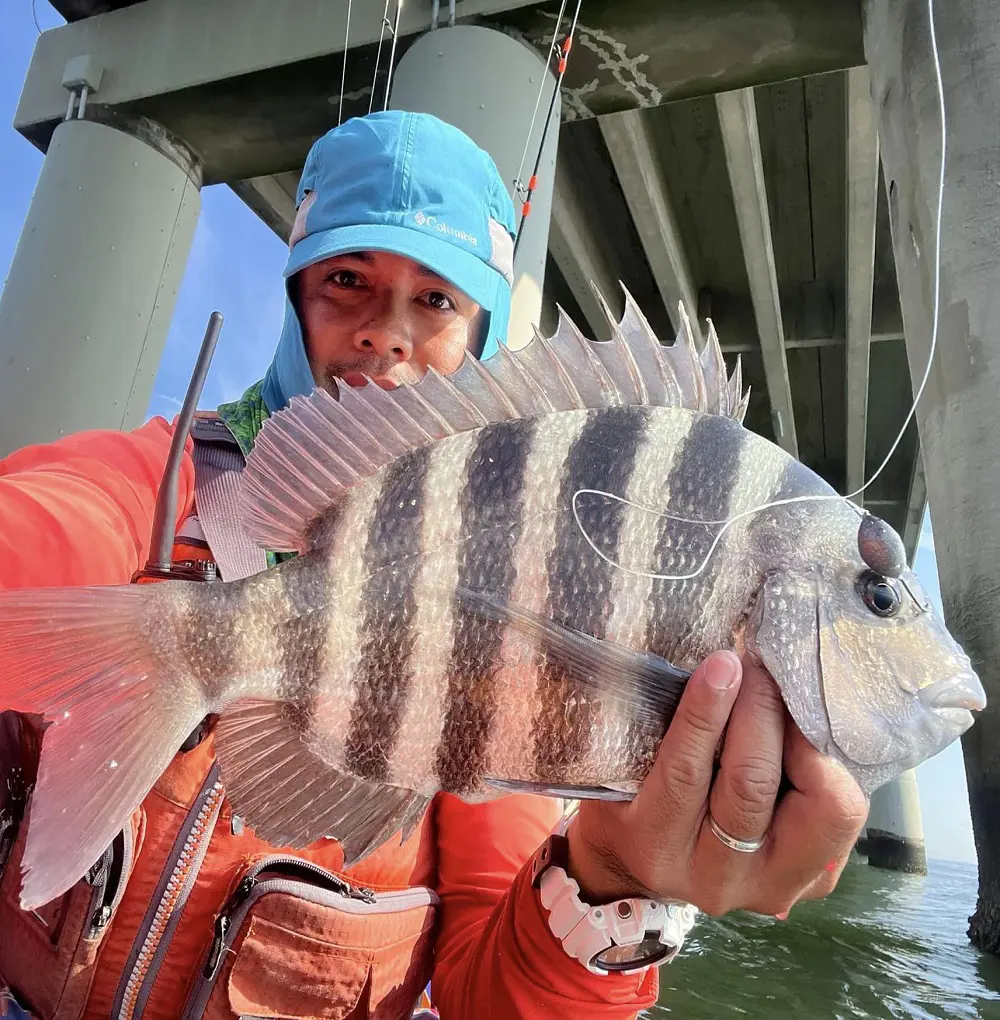
Winter seasons or the cooler months are the best time of the year to catch the Sheepshead as they are more likely to be accessible during that time. During warmer seasons of hotter months, they usually go deep down into the water and become inactive as they congregate in inshore shallows in the cooler months.
In cooler conditions, they reproduce and are the best conditions for their feeding. Sheepshead are largely found around structures like dock and bridge pilings, mangroves, etc. They normally eat crabs, shrimp, oysters, and mussels during the cooler months.
Rather than using artificial baits and lures, it is best to use live or frozen baits as they are good sources of food and the chances rate of getting them increases drastically in the winter season. So, winter or cooler months are the best times to go Sheepshead fishing.
9. Fish in Productive Spots
Though this sheepshead may be found across the eastern Atlantic coast, including the Gulf of Mexico, certain locations produce more than others. Some of the most productive states for fishing sheepshead are Florida and Texas.
Florida
It is one of the best locations for overall fishing, not just for Sheepshead fishing. So, it undoubtedly makes it the best spot. South Florida particularly popular for inshore fishery, has plenty of Sheepshead. Talking about other places in Florida that are famous for the Sheepshead fish are:
- Charlotte Harbor: Along with a lot of other fishes, Charlotte Harbor is a natural estuary, tops the list. As mentioned above, it is best to go out there and fish the Sheepshead in the winter months for plenty of it rather than in the summer months.
- The Everglades: People from all over the world come to the Everglades to enjoy fishing as it is among the top destinations for fishing. Various fishes are up for grabs in this natural region of flooded grasslands along with the Sheepshead.
- Destin: One of the cities in Florida is also known as the "world’s luckiest fishing village" because it has direct access to the Gulf of Mexico and enjoys a variety of fish species.
Texas
Second to Florida, Texas boasts the wildest varieties of fishing species along with the Sheepshead. Around the Texas Gulf Coast, mainly in reefs, jetties, and rocks. Meanwhile, the waters of South Texas are ranked among the best spots for fishing in the state. Here are some of the popular places for fishing in Texas:
- Corpus Christi: For inshore fishing, as well as Sheepshead fishing, Corpus Christi is quite famous and people from all over the world go there to enjoy fishing. During the winter season, the rocky jetty at Packery Channel is the one you should visit for the best fishing experience.
- Galveston: Along with Sheepshead, this bayside is also known for various other species such as redfish, speckled trout, flounder, black drum, etc. While the Gulf is famous for mahi mahi, wahoo, cobia, red snapper, marlin, kingfish, tuna, etc.
- Port O'Connor: This quiet fishing village in Texas, which is at the side of Matagorda Bay is loaded with history as you will get to fish plenty of Sheepshead here. To avoid crowds, Port O'Connor is the perfect destination for fishing Sheepshead or any fish species.
Likewise, Mobile in Alabama, Ocean City in Maryland, Lake Charles in Louisiana, and Biloxi in Mississippi are other places that are popular for fishing, especially Sheepshead fishing. When the reproduction season or spawning season strikes, Alabama's Mobile Bay will have plenty of Sheepshead for fishing.
Big Sheepies are tons in Louisiana's Lake Charles as the world record sheepshead, which weighed little more than 21 pounds, was found in the seas off Louisiana.
10. Boat Positioning
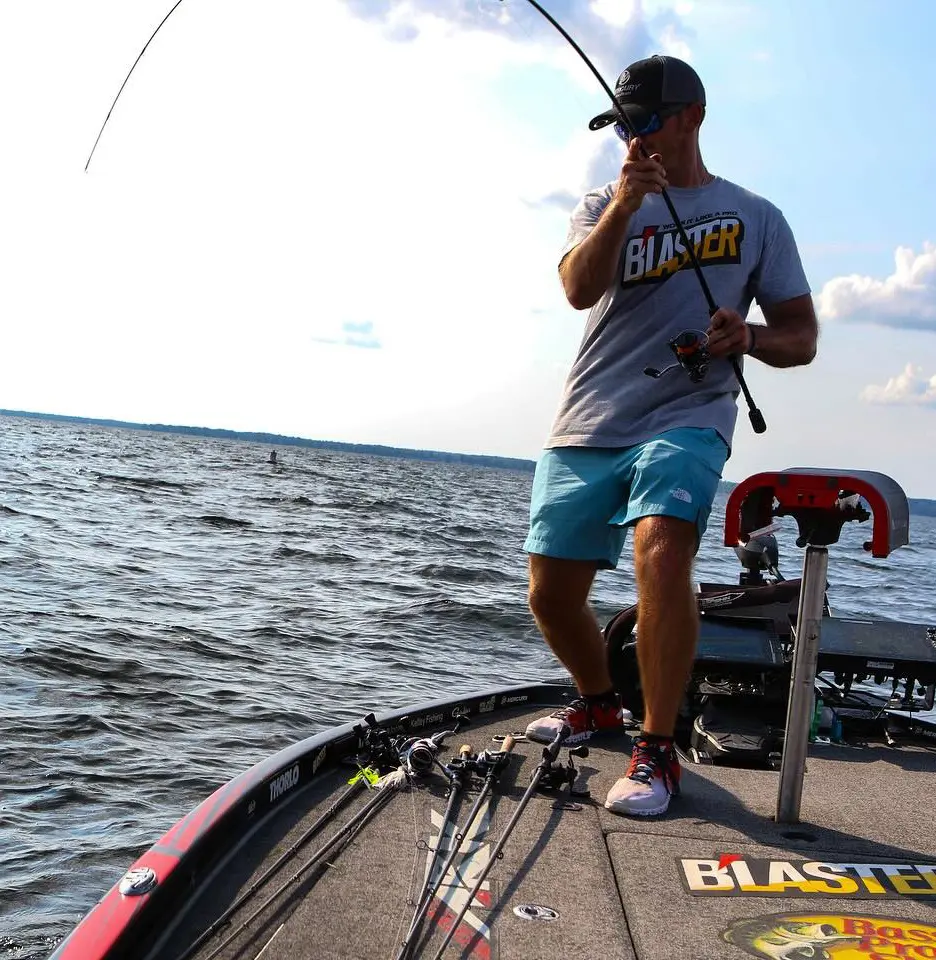
Boat and bait location are two of the most crucial elements in Sheepshead fishing. The bait must be straight on the structure most of the time. When sheepshead is active, they will wander about a little, but the closer the fisherman places the bait to the structure, the more bites they will receive.
Similarly, approaching the structure to be fished from the up-tide side is recommended. After that, the bait will return on its own with the current. Also, fish will be drawn to the bait by the smell. Hence, anglers can fish near or just on top of the structure in deeper water. It's best to anchor a castaway while fishing piers and bars in shallow water.
Here is a detailed tutorial on how to catch Sheepshead fish:
Sheepshead Fishing Technique
Sheepshead fishes are known to steal bait without becoming hooked, so, using circle hooks or J hooks and not setting the hook quickly are effective methods for landing a fish. Rather, the fisherman should raise the rod tip gradually and reel steadily.
The fisherman should reel in any extra line and maintain a low rod tip after casting or dropping the baited hook. The fisherman should not move the bait when a sheepshead nibbles. The fisherman should reel fast and elevate the rod at the same time if the fish starts to move away from the bait.
But after a few nibbles, if the fish does not continue to pull, it's probably been stolen. Even the skilled fisherman encounters something like this.
Facts About Sheepshead Fish
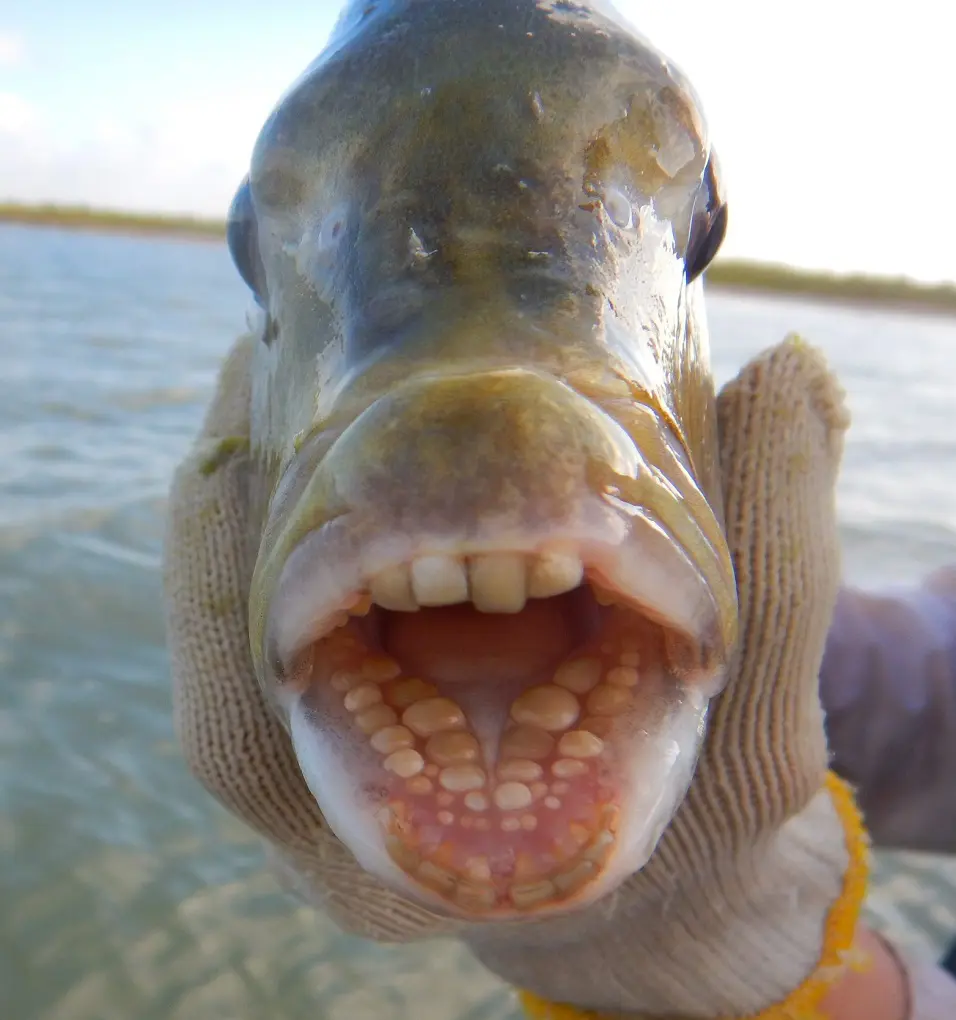
Some interesting and unknown facts about Sheepshead fish are:
Human-Like Teeth
Sheepshead Fish teeth are weird as they resemble the teeth of humans. Similar to humans, their back teeth look like molars and their front teeth are similar to incisors. They break apart the shells of hard-shelled animals with their teeth and eat the flesh.
Unique Flavor
Sheepshead fish flesh has a distinct flavor that is sweet and delicate, similar to the flavor of shellfish. It is considered that the meat absorbs the flavor of the shellfish that the fish consumes.
They Look Dangerous But They Are Not Actually
Despite Sheepshead Fish appearing scary with their teeth and sharp spines on their back, however, they are not dangerous to people. They use their teeth to eat tiny shellfish and do not harm other fish or people.
Sheepshead Reproduction and Rapid Maturity
The Sheepshead deposit their eggs offshore in open waters around 50 ft deep. Depending on the temperature of the water, the eggs can hatch in as little as 28 hours. They grow rapidly, with females maturing in just over a year.


